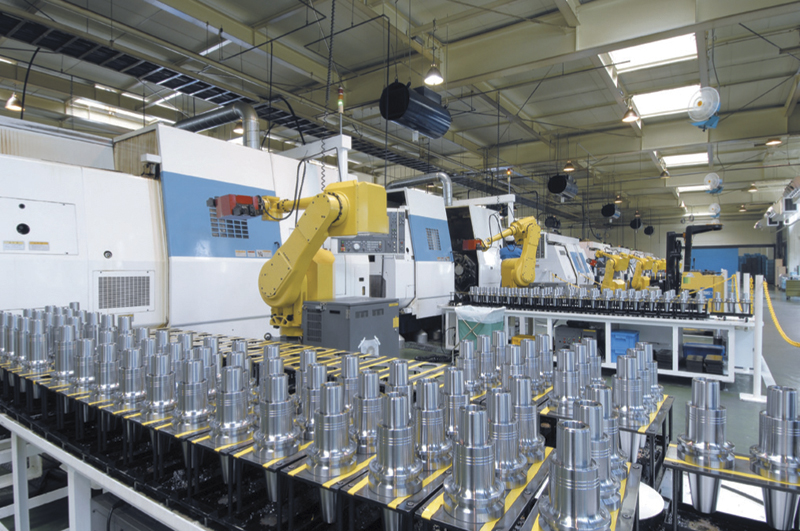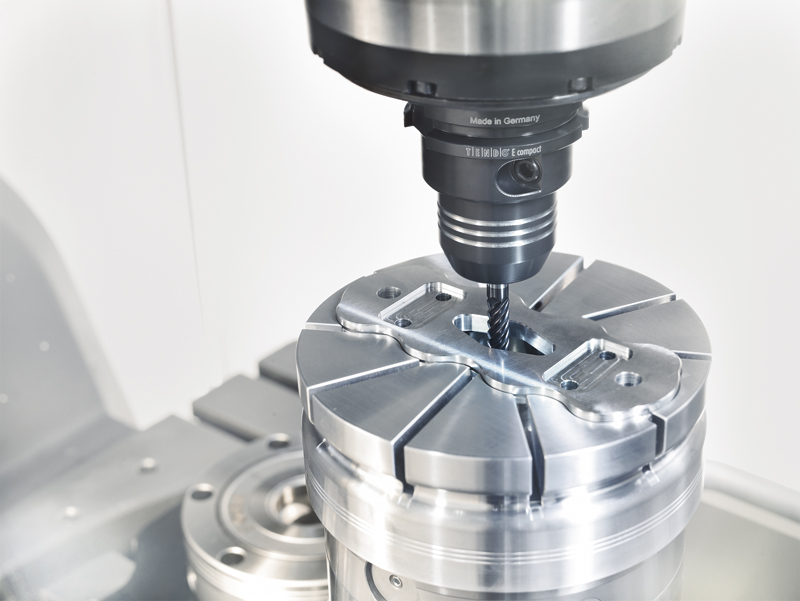by Kip Hanson
The soup to nuts of rotary toolholders
Any shop concerned about the bottom line is always looking for opportunities to cut costs. Why not start with those expensive rotary toolholders? The average price for a 40-taper endmill holder or collet chuck runs around $100 and up. Multiply that by 20 to 30 toolholders for every machining center on the shop floor and you’re looking at some big bucks.
How hard can it be to make your own and keep that hard-earned cash in house? As it turns out, there are some pretty good reasons to leave it to the tooling manufacturers who specialize in it.
We spoke with a few toolholder manufacturers to get some insight into how they produce high quality toolholders.
On your own
As a rule, toolholder manufacturers guard their secrets more closely than Hershey’s does its chocolate recipe. It’s a fiercely competitive business, one with dozens of suppliers and each with its own take on the most accurate way to make a robust toolholder.
It starts with steel. Tooling manufacturers carry a wide variety of materials, from spring steel for collets to the carburizing alloys used for toolholder bodies. If you’re making hydraulic chucks or shrinkfit holders, a premium grade of tool steel such as H13 is a good choice, since this material is resistant to the kind of elastic deformation and cyclical clamping seen in these toolholders. Otherwise, an alloy high in molybdenum and chromium—8620, for example—offers high strength and toughness. And many tooling manufacturers, in search of the perfect balance of toolholder qualities, collaborate with steel manufacturers to develop their own proprietary alloys.
Rough it out
With a big bore CNC lathe, you might barfeed the material, but this would call for a hefty through-hole and a barfeeder able to handle heavy loads—the outside diameter of a CAT-40 collet chuck, for example, finishes at 63.5 mm (2.50 in.). Saw-cut blanks might be a better option. The tapered end of CAT and BT toolholders have a 7/24 angle (3.x5 in./ft.) and measure 68.25 mm (2.687 in.) to the gauge line of the spindle. Add another 100 mm or so for the business end of the toolholder—the part that grips the tool—and the blanks should be sawed to roughly 175 mm (7 in. or so) in length.
You’ll also need a mill-turn centre equipped with a sub-spindle. One of those multi-tasking machines with a large capacity tool magazine would be even better. As with any low-volume, high-mix manufacturing, the flexibility and reduced setup time that comes with a fully-tooled multi-tasker is the bomb, and would easily accommodate the wide variety of toolholders and special orders you’ll soon be producing. For round-the-clock manufacturing, robotic load/unload, inline gauging and automatic tool wear compensation are all requirements. You can expect a cycle time in the 8 to 12 minute range for small, simple toolholders, to an hour or more for very large or complex ones.
Tough but true
Heat treating the semi-finished toolholder comes next. Toolholder bodies made of H13 or equivalent are typically through-hardened to Rc55, making them durable and long-lasting in cyclic applications. Alloy steels are usually case-hardened to a few points below the hardness of the machine spindle—figure Rc60 to Rc62—so that any trapped chips or debris will lodge in the toolholder body itself rather than cause damage to the spindle.
 Most manufacturers leave a small amount of material on each workpiece surface for finishing after heat treat. Critical surfaces such as the taper and bore are ground to size, and all else is hard-turned. Unlike the initial one-step turning/milling operation, finish machining requires multiple operations. Unless you can invest in an automated grinding cell, this is the most labour-intensive part of the toolmaking process, and requires meticulous quality control and handling to achieve a high quality product.
Most manufacturers leave a small amount of material on each workpiece surface for finishing after heat treat. Critical surfaces such as the taper and bore are ground to size, and all else is hard-turned. Unlike the initial one-step turning/milling operation, finish machining requires multiple operations. Unless you can invest in an automated grinding cell, this is the most labour-intensive part of the toolmaking process, and requires meticulous quality control and handling to achieve a high quality product.
A balancing act
With the increased prevalence of high speed machining centres today, pre-balanced toolholders are almost mandatory. This is especially true with CAT style toolholders, which, due to their unequal slot depth at the V-groove, are naturally less balanced than BT or HSK holders. A CAD system able to analyze rotational centre of gravity goes a long way towards designing a balanced tool, but the rest is done through material removal—drilling small holes in strategic locations. If you want to save some headache downstream, this can often be done prior to heat-treating, but tools that spin upwards of 20,000 rpm may require additional balancing after final machining. If you don’t already have a balancer, figure on at least $30,000 or so for a good one, more if you want an automated, intelligent system able to balance a wide variety of toolholders and capable of high throughput.
 There’s plenty more to making toolholders than this. Determining the correct sequence of finishing operations will ultimately determine tool accuracy. How hard and how deep to heat treat the toolholder impacts service life and dampening characteristics, as does the choice of steel. Hydraulic toolholders require a brazing operation to secure the internal gripping sleeve, collet chucks may use rolled threads for greater strength, shrink-fit holders require extensive cycle testing and specific material properties to assure long tool life. And even the best toolholder may fail if poor quality collets or retention knobs are used, which is why many toolholders bring these critical components in house.
There’s plenty more to making toolholders than this. Determining the correct sequence of finishing operations will ultimately determine tool accuracy. How hard and how deep to heat treat the toolholder impacts service life and dampening characteristics, as does the choice of steel. Hydraulic toolholders require a brazing operation to secure the internal gripping sleeve, collet chucks may use rolled threads for greater strength, shrink-fit holders require extensive cycle testing and specific material properties to assure long tool life. And even the best toolholder may fail if poor quality collets or retention knobs are used, which is why many toolholders bring these critical components in house.
Considering the time investment and engineering know-how needed for toolholder design, process development, programming, procurement and outside processing, you’re better off leaving the toolholders to the experts and focusing on what you do best: making parts. SMT
Contributors to this article include:
BIG Kaiser Precision Tooling Inc.
Schunk Intec Corp.
